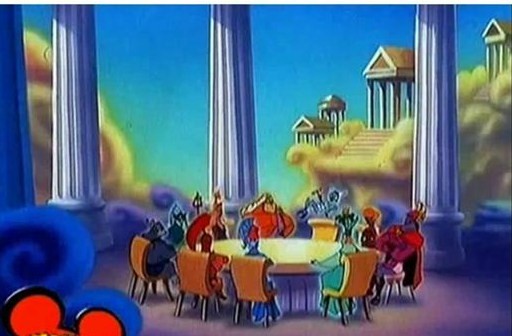Visualization is one of the main reading comprehension strategies. By having students visualize, it makes a mental movie about the text they are reading. It also helps students connect with the text in memorable ways. The following link will lead you to an article about visualization, why it's important, and how to use it in your classroom: Visualization Information. It's a piece written for profession development that can be really useful in your classroom and adaptable to any text. I'm going to try to show you some ideas for connecting through these books using visualization.
Book I discusses the council of the gods, Odysseus's struggle home, and Telemachus' problem with the suitors.
Students having a hard time picturing the gods? (found at: Council of gods source)
This picture, albeit not from the Odyssey, connects with something the kids probably know--a Disney movie--and can help them picture what it might look like to have all the gods gathering to talk. It's very similar to a business meeting or family get-together.
Book II discusses the suitors of Penelope and Telemachus' confrontation with them and help from Athena. For a classic picture, try showing students this one. It can be found at the following link: Classical Penelope.

Book III is about Telemachus' feast and discussion Nestor. Do you think students can imagine what a mighty feast would be like to the ancient Greeks? Yeah, probably a little something like this picture (found at Harry Potter feast source). Students definitely have seen what a giant feast looks like; showing them this might give them some idea what it was like for Telemachus and his men.

Book IV is about Telemachus' meeting with Menelaus. It's important in that Telemachus finds out that Odysseus isn't dead. He's being held captive my Calypso. Students are bound to have seen Pirates of the Caribbean. They can start to picture who this woman is if you show them this (found at Calypso source) and they can begin to see how she can relate to the story. If students have a picture of who she is or what she looks like, they can connect to the text more.

Book V is important because it shows us Odysseus (finally) and how he gets off of Calypso's island. We also see how mad Poseidon is at Odysseus. The Percy Jackson books have become popular lately, so popular that there are movies about them and trust me, kids have seen them. Show them this picture (found at Poseidon source). By showing them this image of Poseidon, they'll 1) recognize someone they've seen before and 2) they'll begin to see that the gods are very human-like, not only in behavior, but appearance as well. This might help students understand that the gods can be temperamental.
Book VI is where Odysseus runs ashore and meets Nausicaa. It probably isn't hard for students to visualize, then giggle, about Odysseus washing ashore in the nude. Showing them this classical picture (Odysseus and olive branch source) might make them realize it's more than a scene where Odysseus has to cover up his manhood, but where he actually might be saved. He receives a lot of help from Athena.
This has been fun, finding pictures. There's also a video put out by Sparknotes that gives a summary of the first six books (it's below the text). Once you've made it through those with the kids, it might be cool to show them the video so they can see them in entirety and go over the plot.
Naysayers: Why in the world did she do this? It doesn't seem important.
Let me tell you why, you negative Nancys. We live in a world where there's media at the click of a mouse. Why not use this to help students visualize what is going on? I guarantee after seeing pictures or watching video students have a better idea and memory of the plot and scene. If they see it, it might also help them to dissect the crucial moments of the text.
If you want some ideas of how to incorporate this in your classroom, go to this link: Visualization Strategies. They have a lot of useful ideas on how to make this and other visualizing activities work.
Tomorrow is Books VII-XII. It's pretty good stuff, let me tell you. Odysseus is a stud.
Remember. Visualize.
Cassy



No comments:
Post a Comment